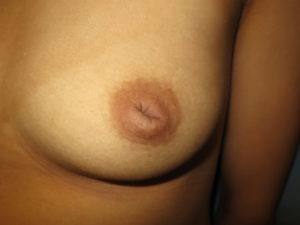Nipples & Plastic Surgery – What is normal, what can be changed?

I love giving interviews for magazines! Why? Because there is so much MISinformation and BAD information out there about Plastic Surgery, cosmetic procedures and the latest trends in beauty. I want to help EDUCATE the public about what is real, what is not, and when you should/shouldn’t have surgery.
My most recent published interview is all about nipples. Hairy nipples, bumpy areolas, accessory (extra) nipples, stretched-out or enlarged hanging nipples, enlarged saucer-like areolas… You get the picture.
You can find the original article on the Women’s Health Magazine website: “8 Nipple Symptoms That Are Totally Normal – Inverted nipples, areola hair, and elongated nips are usually nothing to freak out about.” The author, Anna Medaris Miller, did a great job compiling this information in an easy-to-read way!
I love the illustrations that accompanied the article. So much so, I included them here! To hear more of my thoughts on different types of nipples and areolas, the types I see in my office and what can be done to change them, if desired, read on:

Inverted nipples
Inverted nipples are something I see in my office every week. Why are they bothersome? Most women with inverted nipples don’t like the little slit that sits on the nipple, and there is often asymmetry of the nipples that makes them self-conscious in intimate settings. Breast feeding usually still is possible, and sometimes the suction of a baby’s mouth actually can correct this problem! (in mild cases).
What can be done to correct indented nipples? Inverted nipple correction is a simple outpatient office procedure performed under local anesthetic in the office. Work can resume the next day, oral pain medication is usually required for 24 hours, and exercise should be avoided for around 10 days afterward. We take a conservative approach in women who have not yet had children to allow for future breast feeding. Learn more about it in my nipple correction blog posts.

Stretched-out nipples
Elongated nipples, stretched out or “hypertrophic nipples” are also quite common, especially after breast feeding. Suction from a baby’s mouth cannot only correct mildly inverted nipples, but it can cause nipples to stretch out. Usually, after nursing babies, there is a degree of “deflation” of breast tissue, so that there is a less stable base under the nipple. This can cause the nipples to be floppy and roll around on the breast.
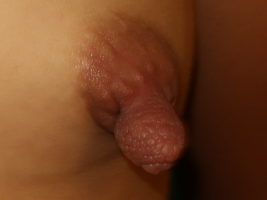
Hypertrophic or enlarged nipple
What can be done for this? Well, enlarged nipples can have a nipple reduction. Floppy nipples can have a nipple stabilization procedure. Each involves making a small incision at the base of the nipple to stabilize its base and remove excess nipple, if indicated. The remaining nipple will regain its sensation and should still function in breast feeding in the future.

Accessory nipples
Extra nipples, also called “third nipples” or “accessory nipples” are actually one of the most common nipple conditions I see! Every week, I usually find up to ten accessory nipples on my patients, most of whom have no idea they have one!
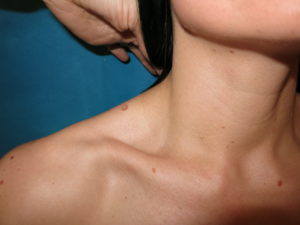
Accessory nipple on the neck
How do accessory nipples form? It’s all about embryology. Human fetuses have a “milk line” of pluripotential cells, each of which has the potential to form a nipple in a line, just like dogs or pigs! The milk line extends from the neck, down the sides of the chest, to the groin and the thigh, both on the front and the back.
Usually, an inhibitory hormone called Mueller’s hormone is expressed that causes the nipples not to form except in the center of the chest. If the hormone is not fully expressed or if it doesn’t reach one particular area on the milk line, then an accessory nipple develops by default.
Accessory nipples have no function and cannot express milk. In carriers of the BRCA gene, they are not thought to pose an increased risk of cancer.
The most common location I see accessory nipples is under the left breast. It looks like a small pigmented nevus (mole) that the patient was born with. Under magnification, you can see areola tissue and sometimes a very small nipple! Accessory nipples can be surgically removed, just like having a mole removed, but you will trade the small pigmented area for a scar.
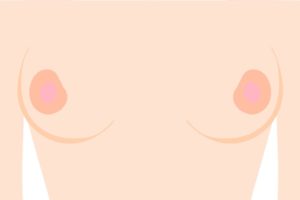
Big areolas
Enlarged areolas are quite common in large breasts, and areola reduction surgery is usually part of a breast reduction or breast lift. To reduce the areola size, incisions are required around the areola and usually below it as well as a vertical “lollipop scar”. See before & after images of areola reductions here.
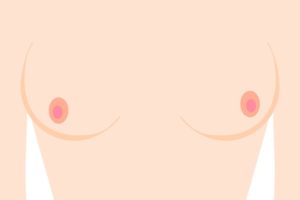
Sideways pointing or low nipples
A breast lift or breast reduction will also centralize nipples and areolas that point out to the side (called “side-winders” or “Eastie-Westies” by my patients) and will lift downward-pointing nipples (called “ptosis” in the medical literature). This usually involves creation of at least a lollipop scar in most cases.
If nipples are a little asymmetric or point off to the side before a breast augmentation, they will stay in that position and possibly be accentuated. However, if nipple are pointing forward and are fairly symmetric before a breast augmentation, then they will stay there and will not suddenly point off to the sides (a common concern of patients).

Hairy areolas
Hairy areolas are totally normal and natural. The amount of hairs varies based on ethnicity and sometimes changes with hormonal changes. I wouldn’t recommend any particular treatment for this, other than plucking the hairs out if you don’t like them. Laser hair removal seems a little harsh, but it is a possibility as well.

Bumpy areolas
Bumpy areolas are normal and natural. The little bumps are called Montgomery glands that function to lubricate the areola. I don’t recommend any surgery to remove these bumps! They serve an anatomic function!
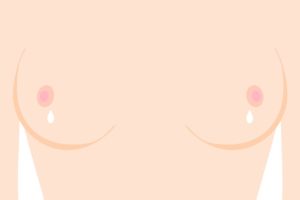
Leaking nipples
Usually, nipples leak milk during lactation (breast feeding), but they can also sometimes leak clear fluid after a procedure like a breast augmentation. This can sometimes occur from to pressure outwards on the nipples from the implants, particularly during breast implant massage. It tends to be temporary. Bloody discharge from a nipple is never normal and should be checked out by a Physician.
To learn more about nipple surgery, visit the Nipple Surgery section of my website. View before and after photographs of nipple repair or reconstruction here.
To schedule a consultation to learn more about nipple surgery, call 415-923-3067 or complete our online consultation form.
~ Karen M. Horton, M.D.

